Ravenheat CSI 85 User Manual
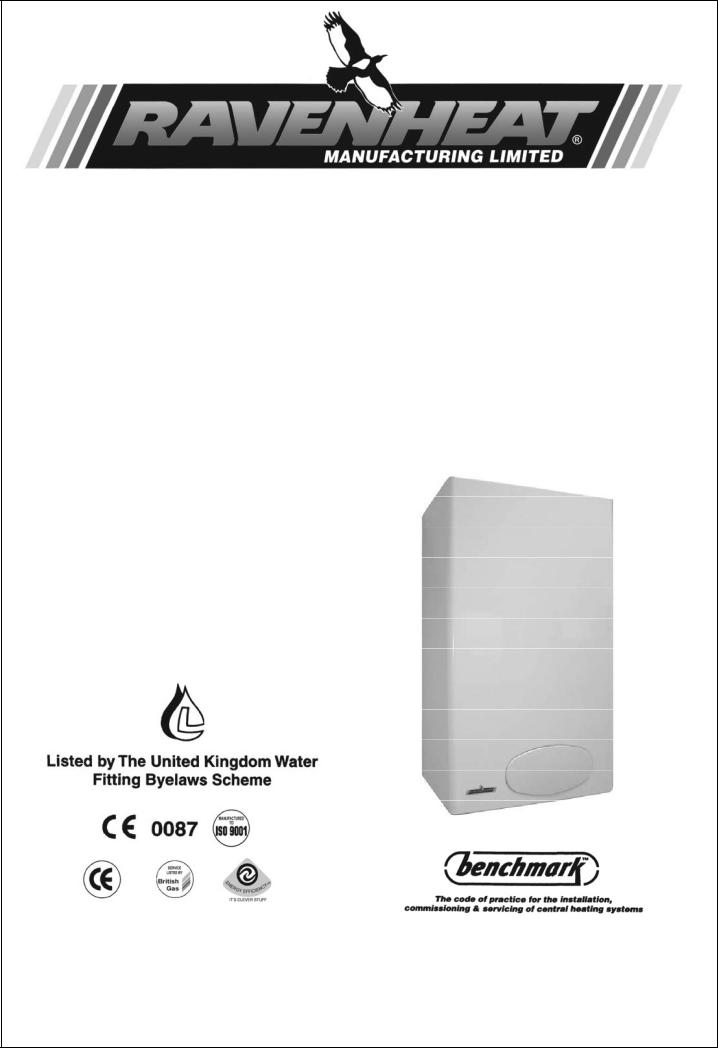
Instructions for Use Installation and Servicing
To be left with the user CSI 85 (T)
780 SERIES
HIGH EFFINCENCY
CONDENSING
COMBINATION BOILER
Natural Gas (G20) I2H - II2H3+
LPG (G30-G31) I3+ - II2H3+
Technical and illustrative data are not binding and can be modified without prior notice. The descriptions and illustrations in the present booklet are for guideline purposes only.
RAVENHEAT MANUFACTURING LTD, CHARTISTS WAY, MORLEY, LEEDS, LS27 9ET TEL. 0044( 0)113 252 7007 - FAX: 0044 (0)113 238 0229
Website : www.ravenheat.co.uk - E-mail : sales@ravenheat.co.uk


CONDENSING SYSTEM INNOVATION AUTOMATIC MODULATING BOILER
FOR CENTRAL HEATING AND DOMESTIC HOT WATER
This new high efficient turbo-modulating boiler is designed to meet domestic hot water and central heating requirements at super high efficiency.
POSITION
The appliance is extremely versatile as it can be fitted in almost any room. The appliance is room sealed, there is no contact between the combustion chamber and living accommodation. This guarantees maximum safety and efficiency. Indeed, our depression/combustion front cover has been designed to fit, achieving maximum air tight seal using screw down fasteners every 15 cm . This should not hinder service of the appliance, but does ensure maximum efficiency and safety - something which Ravenheat takes great pride in.
Each boiler has been designed and manufactured in our modern plant to exacting ISO 9001 discipline and all boilers carry full CE marking of approval. Technical sales and commercial service are available throughout the UK. This product is guaranteed by Ravenheat Manufacturing, Chartists Way, Morley, LEEDS, LS27 9ET. Telephone No (0113) 252 7007.
BASIC COMPONENTS - (See figure 1)
Guarantee is valid for 12 months from date of purchase providing the appliance has been fitted in accordance with these instructions and relevant codes of practice.
|
MAJOR COMPONENTS |
|
|
|
|
- |
Gas valve with flame modulator. |
|
- |
Variable head pump suitable for any type of central heating system. |
|
- |
Burner with flame stabiliser designed to operate under all thermal conditions. |
|
- |
Primary heat exchanger constructed from copper. |
|
- |
Unique patented condensing heat exchanger for high thermal flue transfer gases to water. |
|
- |
Stainless steel plate heat exchanger for super high heat transfer to domestic hot water. |
|
- |
Highly reliable diverter valve with ethylene propylene diaphragm permitting primary flow circulation |
|
|
in the boiler during domestic hot water supply. |
|
- |
Built in frost protection. |
|
- |
Printed circuit board designed to connect to room stat and/or timer/frost stat. Aesthetically pleasing |
|
|
panels and controls. |
|
- |
On/Off ball valves for shutting off gas central heating and domestic hot water circuit Safety relief |
|
|
valve (for safety discharge). |
|
Programmable 7 day module with digital display (optional model).
All front panel controls infrequently used have been hidden. This achieves simplicity of operation with easy to clean panels.
NOTE: Due to the high efficiency of this boiler a plume of water vapour will form at the flue terminal during operation.
COSHH - CONTROL OF SUBSTANCES HARMFUL TO HEALTH
IMPORTANT
This appliance contains materials that are indicated below.
It is the Users/Installers responsibility to ensure that the necessary personal protective clothing is-worn when handling, where applicable. The pertinent parts that contain any materials that could be interpreted as being injurious to health and safety.
WARNING When installing the appliance, care should be taken to avoid any possibility of injury when handling sheet metal parts.
GENERAL INFORMATION:
GLUES AND SEALANTS - exercise caution - if these are still in liquid form.
INSULATION PADS, CERAMIC FIBRE - may be harmful if inhaled, may be irritating to skin, eyes, nose and throat. When handling keep dust generation to a minimum, avoid inhaling and contact with skin or eyes.
When disposing of the product keep dust generation to a minimum and ensure that parts are securely wrapped. When servicing avoid inhalation by using a vacuum cleaner in conjunction with other tools. After handling wash hands and other exposed parts.
RAVENHEAT use only high quality material for production of this product, in an effort to protect the environment components should be re-cycled.
3

SECTIONS |
|
|
|
|
|
|
TABLE OF CONTENTS |
PAGE |
|||||||||||||||||
1 |
|
|
|
|
|
|
|
|
INTRODUCTION |
6 |
|||||||||||||||
2 |
|
|
|
|
|
|
|
|
DESCRIPTION OF CONTROL |
6 |
|||||||||||||||
3 |
|
|
|
|
|
|
|
|
SYSTEM AND SEQUENCE OF OPERATION |
8 |
|||||||||||||||
4 |
|
|
|
|
|
|
|
|
TECHNICAL DATA |
10 |
|||||||||||||||
5 |
|
|
|
|
|
|
|
|
GENERAL REQUIREMENTS |
15 |
|||||||||||||||
6 |
|
|
|
|
|
|
|
|
INSTALLATION |
25 |
|||||||||||||||
7 |
|
|
|
|
|
|
|
|
COMMISSIONING |
30 |
|||||||||||||||
8 |
|
|
|
|
|
|
|
|
SERVICING INSTRUCTIONS |
40 |
|||||||||||||||
9 |
|
|
|
|
|
|
|
|
FAULT FINDING |
42 |
|||||||||||||||
10 |
|
|
|
|
|
|
|
|
ELECTRICAL SYSTEM DIAGRAM |
43 |
|||||||||||||||
|
|
|
|
|
|
|
|
|
INSTALLATION INSTRUCTIONS FOR |
46 |
|||||||||||||||
|
|
|
|
|
|
|
|
|
TWIN FLUE PIPE |
46 |
|||||||||||||||
11 |
|
|
|
|
|
|
|
|
EXPLODED PARTS DIAGRAM |
47 |
|||||||||||||||
12 |
|
|
|
|
|
|
|
|
LIST OF SPARE PARTS |
|
|||||||||||||||
|
|
|
|
|
|
|
|
|
|
|
|
|
|
|
|
|
|
|
|
|
|
|
|
|
|
|
|
|
|
|
|
|
|
|
|
|
|
|
|
|
|
|
|
|
|
|
|
|
|
|
|
|
|
|
|
|
|
|
|
|
|
|
|
|
|
|
|
|
|
|
|
|
|
|
|
|
|
|
|
|
|
|
|
|
|
|
|
|
|
|
|
|
|
|
|
|
|
|
|
|
|
|
|
|
|
|
|
|
|
|
|
|
|
|
|
|
|
|
|
|
|
|
|
|
|
|
|
|
|
|
|
|
|
|
|
|
|
|
|
|
|
|
|
|
|
|
|
|
|
|
|
|
|
|
|
|
|
|
|
|
|
|
|
|
|
|
|
|
|
|
|
|
|
|
|
|
|
|
|
|
|
|
|
|
|
|
|
|
|
|
|
|
|
|
|
|
|
|
|
|
|
|
|
|
|
|
|
|
|
|
|
|
|
|
|
|
|
|
|
|
|
|
|
|
|
|
|
|
|
|
|
|
|
|
|
|
|
|
|
|
|
|
|
|
|
|
|
|
|
|
|
|
|
|
|
|
|
|
|
|
|
|
|
|
|
|
|
|
|
|
|
|
|
|
|
|
|
|
|
|
|
|
|
|
|
|
|
|
|
|
|
|
|
|
|
|
|
|
|
|
|
|
|
|
|
|
|
|
|
|
|
|
|
|
|
|
|
|
|
|
|
|
|
|
|
|
|
|
|
|
|
|
|
|
|
|
|
|
|
|
|
|
|
|
|
|
|
|
|
|
|
|
|
|
|
|
|
|
|
|
|
|
|
|
|
|
|
|
|
|
|
|
|
|
|
|
|
|
|
|
|
|
|
|
|
|
|
|
|
|
|
|
|
|
|
|
|
|
|
|
|
|
|
|
|
|
|
|
|
|
|
|
|
|
|
|
|
|
|
|
|
|
|
|
|
|
|
|
|
|
|
|
|
|
|
|
|
|
|
|
|
|
|
|
|
|
|
|
|
|
|
|
|
|
|
|
|
|
|
|
|
|
|
|
|
|
|
|
|
|
|
|
|
|
|
|
|
|
|
|
|
|
|
|
|
|
|
|
|
|
|
|
|
|
|
|
|
|
|
|
|
|
|
|
|
|
|
|
|
|
|
|
|
|
|
|
|
|
|
|
|
|
|
|
|
|
|
|
|
|
|
|
|
|
|
|
|
|
|
|
|
|
|
|
|
|
|
|
|
|
|
|
|
|
|
|
|
|
|
|
|
|
|
|
|
|
|
|
|
|
|
|
|
|
|
|
|
|
|
|
|
|
|
|
|
|
|
|
|
|
|
|
|
|
|
|
|
|
|
|
|
|
|
|
|
|
|
|
|
|
|
|
|
|
|
|
|
|
|
|
|
|
|
|
|
|
|
|
|
|
|
|
|
|
|
|
|
|
|
|
|
|
|
|
|
|
|
|
|
|
|
|
|
|
|
|
|
|
|
|
|
|
|
|
|
|
|
|
|
|
|
|
|
|
|
|
|
|
|
|
|
|
|
|
|
|
|
|
|
|
|
|
|
|
|
|
|
|
|
|
|
Fig. 1
KEY |
|
|
|
|
|
1 |
- Heat exchanger |
11 - D.H.W. sensor |
21 |
- Combustion chamber |
|
2 |
- Sensing electrode |
12 |
- D.H.W. heat exchanger |
22 |
- Frame |
3 |
- Burner |
13 |
- D.H.W switch |
23 |
- Sealed chamber |
4 |
- Expansion tank |
14 |
- D.H.W inlet |
24 |
- Air pressure switch |
5 |
- Modulating gas valve |
15 |
- Diverter valve motor |
25 |
- Auto air vent |
6 |
- Condensing trap |
16 |
- Low water pressure switch |
26 |
- Fan |
7 |
- C.H. outlet |
17 |
- Circulation pump |
27 |
- Flue restriction ring |
8 |
- Drain point |
18 |
- Overheat cut off thermostat |
28 |
- Condensing heat exchanger |
9 |
- Safety relief system |
19 |
- C.H. sensor |
29 |
- Flue gas exhaust hood |
10 - D.H.W. outlet |
20 |
- Spark electrode |
30 |
- Temperature flue sensor |
|
4
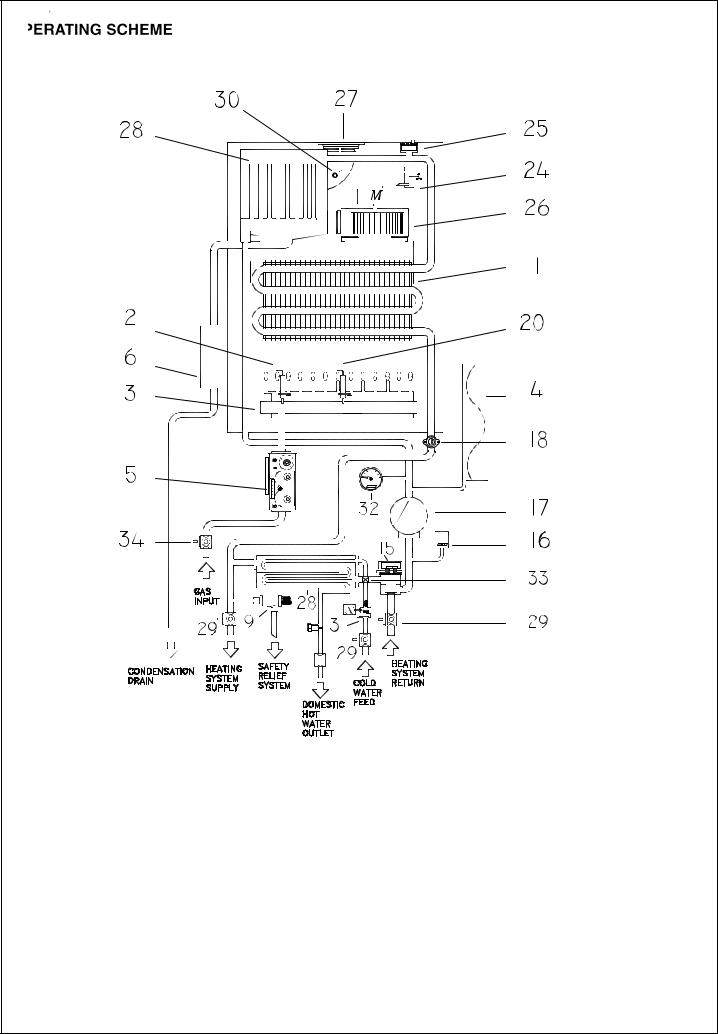
Fig. 2
KEY |
|
|
|
|
|
1 |
- Heat exchanger |
15 |
- Diverter valve motor |
30 |
- Temperature flue sensor |
2 |
- Sensing electrode |
16 |
- Water pressure sensor |
31 |
- Water pressure switch |
3 |
- Burner |
17 |
- Circulation pump |
32 |
- Water pressure gauge |
4 |
- Expansion tank |
18 |
- Overheat cut off thermostat |
33 |
- Automatic by-pass |
5 |
- Modulating gas valve |
20 |
- Spark electrode |
34 |
- Gas service cock |
6 |
- Condensing trap |
24 |
- Pressure switch |
|
|
7 |
- C.H. outlet |
25 |
- Auto air vent |
|
|
8 |
- Drain point |
26 |
- Fan |
|
|
9 |
- Safety relief system |
27 |
- Flue restriction ring |
|
|
10 - D.H.W. outlet |
28 |
- Condensing heat exchanger |
|
|
|
12 - D.H.W. heat exchanger |
29 |
- Compresson ball valves |
|
|
|
5
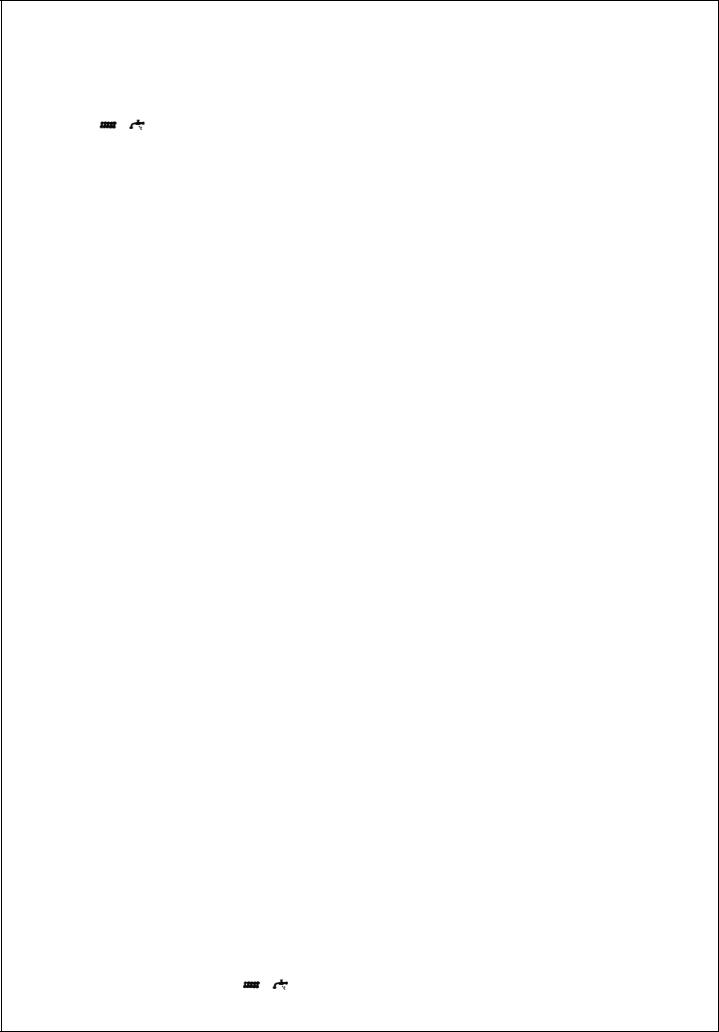
SECTION 1 INTRODUCTION
1.1The Ravenheat boiler is for the use of central heating and domestic hot water combined
in one unit. It is fitted with an automatic domestic hot water priority valve.
A /  (winter/summer) selector switch is fitted to the left hand side of control panel.With the
(winter/summer) selector switch is fitted to the left hand side of control panel.With the  only (summer) position being for domestic hot water.
only (summer) position being for domestic hot water.
 position being for central heating with domestic hot water priority. The boiler is equipped with a front cover which can be removed for servicing. The data badge with technical data is placed on the lower right hand side of the frame.
position being for central heating with domestic hot water priority. The boiler is equipped with a front cover which can be removed for servicing. The data badge with technical data is placed on the lower right hand side of the frame.
1.2Fig.1.
Illustrates the general layout of components. Fig. 2.
Illustrates the operating scheme described in section 2.
SECTION 2
2.1DESCRIPTION OF CONTROL SYSTEM AND SEQUENCE OF OPERATION
2.2Domestic hot water mode.
When the appliance is in rest mode with the mains neon switch on.
Switch the summer/winter switch tap  position, with the heating circuit charged with water (above 1 bar). If the domestic hot water tap is turned on, the boiler will function in the following sequence:
position, with the heating circuit charged with water (above 1 bar). If the domestic hot water tap is turned on, the boiler will function in the following sequence:
2.2.1The pump starts.
The control board sensors.
The fan operates via the pressure switch and sends a signal back to the ignition board that the fan is running at maximum speed.
2.2.2The spark ignition system is powered which in turn commences the spark igniter to operate and light the burner.
At this point the ignition board opens the gas valve to light the burner.
2.2.3When the electrode/sensor senses the signal of the burner, the spark igniter stops.
2.2.4From the minimum gas rate setting the boiler increases to the maximum permissible pressure over a period of 3 to 4 seconds and will remain at its maximum required power until it reaches maximum regulated temperature.
2.2.5When the domestic hot water tap is closed the diverter valve goes back into rest mode, the main burner is shut down along with the pump and fan which are also switched off.
The pressure switch returns to its rest mode
2.2.6Central heating mode
2.2.7 |
If the switch is positioned on |
with |
|
a demand for heat to supply radiators, with |
|
the heating circuit fully pressurized so as to operate the low water sensor device the boiler will start in the same way in domestic hot water mode but with slightly differing time delay. In that it will start on minimum and remain at this level for about 1 minute. After which the flame will lift to its maximum setting as governed by a potentiometer which range rates the heating circuit between maximum and minimum power. As the heating sensor reaches temperature the gas burner power modulates down, the fan speed
will also reduce to minimum fan speed. When starting, the fan will always start at maximum speed.
2.2.8On the control panel are mounted two potentiometers (thermostats) these control the temperature. One is for domestic hot water and the other for heating.
2.2.9The boiler is fitted with an anti-cycling device on the control board. This delays the boiler from re-firing over a 2/5 minute period when in heating mode. The domestic hot water will always take priority and is unaffected by the anti-cycling device.
GENERAL FUNCTION
2.3Central Heating Mode
2.3.1A potentiometer installed on the electric circuit board permits regulation of the boiler to partial heating requirements, between maximum and minimum settings.
2.3.2Air is drawn by the fan for combustion.
2.3.3Thefanalsoforcesexhaustgasthroughtheflue to the outside, this creates a lesser pressure in the sealed combustion chamber, thus sucking in combustion air, through the inlet duct.
2.3.4The boiler water temperature is automatically controlled by a built in thermostat
2.3.5Interior space temperature is set by the room thermostat to be installed in the heating system. The boiler already carries connection terminals for this thermostat, as well as for a timeclock.
The burner continues to operate until it is stopped by the timer or one of the thermostats
2.3.6When the internal C.H. temperature sensor intervenes the main burner shuts down. The fan stops but the pump continues to operate.
2.3.7When the room thermostats intervene the main burner shuts down. The fan stops and the pump turns off.
2.3.8The condensate trap is fitted with a blockage safety sensor. This prevents the boiler operating should there be a blockage in the condensate discharge trap.
6

2.4Domestic hot water mode
2.4.1The heat exchanger in the D.H.W. circuit is built into the main heat exchanger, and domestic hot water is heated by converting the water in the central heating circuit. The transference of heat is very high because the two fluids move in a counter direction flow to each other.
2.4.2 Select (fig. 35) the  winter position. When a hot water tap is turned on a diaphragm diverter valve excludes the central heating circuit, the boiler automatically modulates to maintain the domestic hot water at a constant temperature.
winter position. When a hot water tap is turned on a diaphragm diverter valve excludes the central heating circuit, the boiler automatically modulates to maintain the domestic hot water at a constant temperature.
Water temperature can be regulated using the D.H.W. thermostat located on the front control panel.
2.4.3When domestic hot water is being drawn the main burner and pump perform as they do during central heating except that the burner is commanded by the D.H.W. thermostat.
OVERALL DIMENSION
Fig. 3
2.4.4When D.H.W. is no longer called for the boiler automatically returns to the central heating mode.
2.4.5Select (fig. 35) the  summer position the boiler functions like an automatic gas hot water heater. When D.H.W. is no longer required the main burner fan and pump
summer position the boiler functions like an automatic gas hot water heater. When D.H.W. is no longer required the main burner fan and pump
immediately turn off. |
|
This also takes place with |
the summer/ |
winter switch if there is no demand for
heat |
to |
the central heating system or |
until |
the |
room thermostat/time clock |
demands from the central heating circuit the main burner fan and pump turn off immediately. .
2.5SAFETY DEVICE
In both central heating and domestic hot water mode safe operating is ensured by:
2.5.1A differential pressure switch which shuts off the main burner if the fan stops or the flue or combustion air intake duct is obstructed.
An overheat cut off thermostat set slightly higher than the high limit thermostat acts to turn of the burner to resetable “lockout” (Fig. 35) item 3.
2.5.2A safety valve is fitted on the central heating circuit set at 43 psi (3 bar).
2.5.3A heating circuit (low water) pressure switch is set at 0.4 bar.
7

SECTION 3 TECHNICAL DATA
CSI 85 (T) 780 Series
TABLE 1
NATURAL GAS (G 20) І2H - П2H3+
NOMINAL HEAT INPUT NET QMS |
|
24.8 kW |
||
MINIMUM HEAT INPUT NET |
|
13.0 kW |
||
NOMINAL HEAT OUTPUT |
|
23.8 kW |
||
NOMINAL HEAT OUTPUT CONDENSING |
26.2 kW |
|||
MINIMUM HEAT OUTPUT |
|
10.6 kW |
||
MINIMUM HEAT OUTPUT CONDENSING |
13.7 kW |
|||
|
|
|
|
|
GAS RATE |
|
max |
2.5 m3/h |
|
AFTER 10 MINUTES |
|
min |
1.3 m3/h |
|
INLET PRESSURE |
|
20 mbar |
||
|
|
|
|
|
BURNER PRESSURE C.H. |
|
max |
10.5 mbar |
|
|
|
|
min |
2.0 mbar |
|
MAIN BURNER INJECTORS |
Nr. 13 x 1.25 |
|
|
ELECTRICAL SUPPLY |
230 V ~ 50 HZ |
|
||
POWER CONSUMPTION |
150 W |
|
|
|
EXTERNAL FUSE RATING |
3A |
|
|
|
INTERNAL FUSE |
3.15 A |
(20 mm to BS 4265) |
||
DRY WEIGHT |
46 kg |
|
|
|
WATER CONTENT C.H. |
2.1 litre |
|
|
|
WATER CONTENT |
0.5 litre |
|
|
|
|
|
|||
GAS SUPPLY CONNECTION |
15 mm compression isolating valve |
|||
FLOW CONNECTION C.H. |
22 mm compression isolating valve |
|||
RETURN CONNECTION C.H. |
22 mm compression isolating valve |
|||
INLET CONNECTION D.H.W. |
15 mm compression isolating valve |
|||
OUTLET CONNECTION D.H.W. |
15 mm compression |
|
||
SAFETY DISCHARGE C.H. |
15 mm copper pipe |
|
||
CONDENSATION DRAIN |
3/4” (21.5 mm) push fit over flow |
|||
MAX COLD WATER CAPACITY WITHOUT ADDITIONAL EXPANSION VESSEL 110 LITRE |
||||
SEALED WATER SYSTEM C.H. |
|
|
|
|
MAX PRESSURE PHS |
|
|
2.5 bar |
|
MINIMUM WORKING PRESSURE |
|
|
0.5 bar |
|
7 LITRES EXPANSION VESSEL PRE-CHARGE-PRESSURE |
0.5 bar |
|||
CENTRAL HEATING OPERATING TEMPERATURE |
MAX 85°C |
MIN 45°C |
||
DESIGN FLOW RATE 1102 I/h 20 °C RISE |
|
|
||
MINIMUM FLOW RATE C.H. 503 I/min |
|
|
|
|
D.H.W. FLOW RATE 30 °C rise |
13.2 l/min |
|
|
|
D.H.W. FLOW RATE 35 °C rise |
11.0 l/min |
|
|
|
D.H.W. FLOW RATE 40 °C rise |
9.2 l/min |
|
|
|
D.H.W. TEMPERATURE |
max 65 °C |
|
min 35 °C |
|
BURNER PRESSURE D.H.W. |
max 11.2 mbar |
min 2.5 mbar |
||
Qmw Input Net |
max 26.0 kW |
|
min 13.0 kW |
|
D.H.W. PRESSURE |
max 10 bar (147 p.s.i.) |
|
||
D.H.W. PRESSURE PMW |
min 0.8 bar (118 p.s.i.) To obtain heat input 1.2 bar |
|||
D.H.W. MINIMUM FLOW RATE |
3 I/min |
|
|
|
FLUE OUTLET NOM. DIAMETER 100 mm specially supplied with boilers |
||||
DESTINATION: AT, DK, Fl, SE, |
CATEGORY I2H |
|
||
DESTINATION: GB, IE, CH, ES, IT, PT |
CATEGORY II2H3+ |
|
||
FLUE TYPE - C12 - C32 - C52 |
NOX 4 |
|
|
|
|
|
|
|
|
8
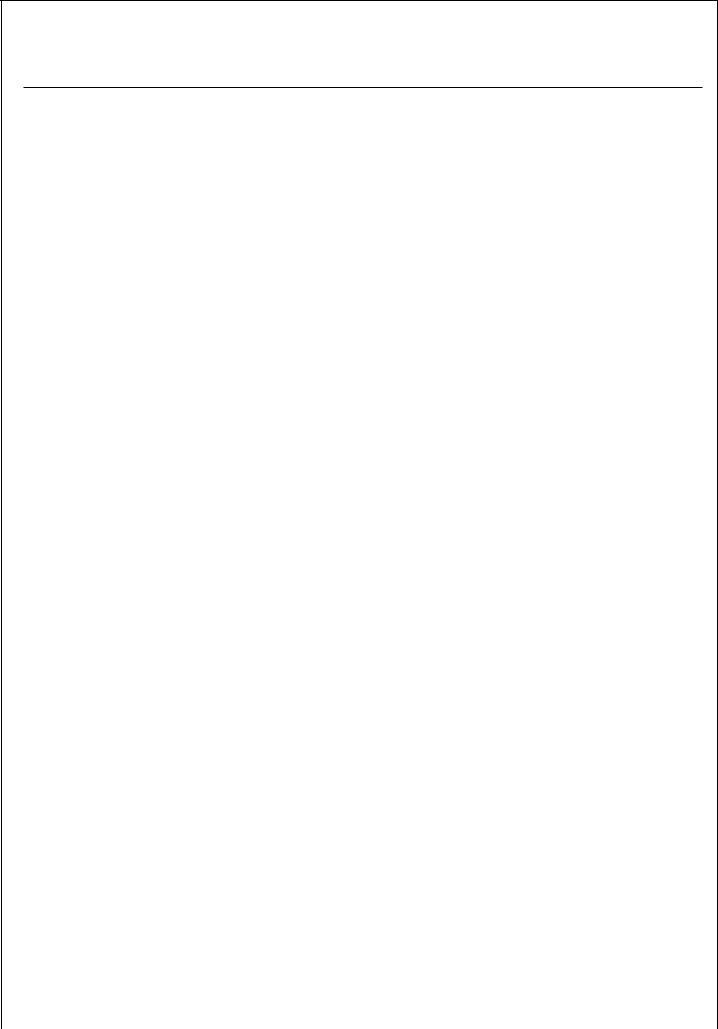
SECTION 3 TECHNICAL DATA
CSI 85 (T) 780 Series
TABLE 1/A
LPG (G 30 - G 31) І3+ - П2H3+
|
|
NOMINAL HEAT INPUT NET QMS |
|
|
24.8 kW |
|
|
|
|
|
|
MINIMUM HEAT INPUT NET |
|
|
13.0 kW |
|
|
|
|
|
|
|
|
|
|
|
|
|
|
|
NOMINAL HEAT OUTPUT |
|
|
23.8 kW |
|
|
|
||
|
NOMINAL HEAT OUTPUT CONDENSING |
|
26.2 kW |
|
|
|
|||
|
MINIMUM HEAT OUTPUT |
|
|
10.6 kW |
|
|
|
||
|
MINIMUM HEAT OUTPUT CONDENSING |
|
13.7 kW |
|
|
|
|||
|
|
|
|
|
|
|
|
||
|
GAS RATE |
|
|
max |
G31 0.9 m3/h |
G30 0.7 m3/h |
|||
|
AFTER 10 MINUTES |
|
|
min |
0.5 m3/h |
0.4 m3/h |
|||
|
INLET PRESSURE |
G31 37mbar |
G30 28-30 mbar |
|
|
|
|||
|
|
|
|
|
|
|
|
||
|
BURNER PRESSURE C.H. |
|
|
max |
G31 35.4mbar |
G30 27.3 mbar |
|||
|
|
|
|
|
min |
7.3 mbar |
7.0 mbar |
||
|
|
MAIN BURNER INJECTORS |
Nr 13 x 0.75 |
|
|
|
|
|
|
|
ELECTRICAL SUPPLY |
230 V ~ 50 HZ |
|
|
|
|
|
|
|
|
POWER CONSUMPTION |
150 W |
|
|
|
|
|
|
|
|
EXTERNAL FUSE RATING |
3A |
|
|
|
|
|
|
|
|
INTERNAL FUSE |
3.15 A |
|
|
(20 mm to BS 4265) |
|
|
|
|
|
DRY WEIGHT |
46 kg |
|
|
|
|
|
|
|
|
WATER CONTENT C.H. |
2.1 litre |
|
|
|
|
|
|
|
|
WATER CONTENT |
0.5 litre |
|
|
|
|
|
|
|
|
|
|
|
|
|
||||
|
GAS SUPPLY CONNECTION |
15 mm compression isolating valve |
|
|
|
||||
|
FLOW CONNECTION C.H. |
22 mm compression isolating valve |
|
|
|
||||
|
RETURN CONNECTION C.H. |
22 mm compression isolating valve |
|
|
|
||||
|
INLET CONNECTION D.H.W. |
15 mm compression isolating valve |
|
|
|
||||
|
OUTLET CONNECTION D.H.W. |
15 mm compression |
|
|
|
|
|||
|
SAFETY DISCHARGE C.H. |
15 mm copper pipe |
|
|
|
|
|||
|
CONDENSATION DRAIN |
3/4” (21.5 mm) push fit over flow |
|
|
|
||||
|
MAX COLD WATER CAPACITY WITHOUT ADDITIONAL EXPANSION VESSEL 110 LITRE |
||||||||
|
|
|
|
|
|
|
|
|
|
|
SEALED WATER SYSTEM C.H. |
|
|
|
|
|
|
|
|
|
MAX PRESSURE PHS |
|
|
|
2.5 bar |
|
|
|
|
|
MINIMUM WORKING PRESSURE |
|
|
|
0.5 bar |
|
|
|
|
|
6 LITRES EXPANSION VESSEL PRE-CHARGE-PRESSURE |
0.5 bar |
|
|
|
||||
|
CENTRAL HEATING OPERATING TEMPERATURE MAX 85°C |
MIN 35°C |
|
|
|
||||
|
|
|
|
|
|
|
|
||
|
DESIGN FLOW RATE 1102 I/h 20 °C RISE |
|
|
|
|
|
|
||
|
MINIMUM FLOW RATE C.H. 503 I/min |
|
|
|
|
|
|
|
|
|
D.H.W. FLOW RATE 30 °C rise |
13.2 l/min |
|
|
|
|
|
|
|
|
D.H.W. FLOW RATE 35 °C rise |
11.0 l/min |
|
|
|
|
|
|
|
|
D.H.W. FLOW RATE 40 °C rise |
9.9 l/min |
|
|
10°C inlet temperature |
||||
|
D.H.W. TEMPERATURE |
max 65 °C |
|
|
min 35 °C |
|
|
|
|
|
|
|
|
|
|
|
|||
|
BURNER PRESSURE D.H.W. |
MAX G31 35.4 - |
G30 27.3 mbar |
|
|
|
|||
|
|
|
MIN G31 7.3 |
- |
G30 7.0 mbar |
|
|
|
|
|
Qmw Imput Net |
MAX 26.0 kW |
- |
MIN 13.0 kW |
|
|
|
||
|
D.H.W. PRESSURE |
max 10 bar (147 p.s.i.) |
|
|
|
|
|||
|
D.H.W. PRESSURE PMW |
min 0.8 bar (11.8 p.s.i.) To obtain heat input 1.2 bar |
|||||||
|
D.H.W. MINIMUM FLOW RATE |
3 I/min |
|
|
|
|
|
|
|
|
FLUE OUTLET NOM. DIAMETER 100 mm specially supplied with boilers |
|
|
|
|||||
|
DESTINATION: BE, FR |
CATEGORY I2H+ |
|
|
|
|
|
||
|
DESTINATION: GB, IE, CH, ES, IT, PT |
CATEGORY II2H3+ |
|
|
|
|
|
||
|
|
FLUE TYPE - C12 - C32 - C52 |
NOX 4 |
|
|
|
|
|
|
|
|
|
|
|
|
|
|
|
|
|
|
|
|
|
|
|
9 |
|
|

SECTION 4 GENERAL REQUIREMENTS
4.1SAFETY
Gas Safety (Installation and Use). Regulations.
It is law that all gas appliances are installed and serviced by a registered installer in accordance with the above regulations and these installation instructions. All registered installers carry a I.D. card and have a registration number. Both should be recorded in your boiler log book. You can check your installer in the gas safe register. Failure to install appliances correctly could lead to prosecution. It is in your own interest, and that of safety, to ensure the law is complied with.
The installation of the boiler MUST be in accordance with the latest I.E.E. (BS 7671) Wiring Regulations, local building regulations, bye-laws of the local water authority, the building regulations and the Building Standards (Scotland) and any relevant requirements of the local authority.
4.1.1GENERAL INFORMATION
Both the user and the manufacturer rely heavily on the installer, whose job it is to
install the combination boiler and connect it to a correctly designed heating system. Acquaint yourself with the British Standards concerning installation requirements. If you need advice on any points your Ravenheat Technical Services Office would be pleased to help. It is recommended that tools suitable for brass fittings are used, and have a capability to accomodate hexagon sizes up to 50 mm.
CODES OF PRACTICE/Ref: Documents
Detailed recommendations are contained in the following British Standard Codes of Practice:
BS.6891 Low pressure installation pipes.
BS.6798 Installation of gas fired hot water boilers of rated input not exceeding 60 kW.
BS.5449 Forced circulation hot water systems.
BS.5546 Installation of gas hot water supplies domestic purposes (2nd Family Gases).
BS.5440: 1 Flues (for gas appliances of rated input not exceeding 60 kW).
BS.5440: 2 Ventilation (for gas appliances of rated input not exceeding 60 kW).
DD 189: 1990 Discharge of condensate.
Health & Safety Document No.635
The Electricity at Work Regulations, 1989.
The manufacturer’s notes must NOT be taken, in any way, as overriding statutory obligations.
IMPORTANT:
These appliances are CE certificated for safety and performance. It is, therefore, important that no external control devices e.g. flue dampers, economisers etc. are directly connected to this appliance unless covered by these Installation and Service Instructions or as otherwise recommended by Ravenheat in writing. If in doubt please enquire.
Any direct connection of a control device not approved by Ravenheat could invalidate the certification and the normal appliance warranty.
It could also infringe the Gas Safety regulations and the above regulations.
NOTE:
The Ravenheat CSI 85 (T) 780 series combination boiler has been tested and examined by ADVANTICA, and is certified to comply with PrEN 483 and BS EN 625.
4.2LOCATION OF BOILER
4.2.1Siting of the Ravenheat CSI 85 (T) 780 series Combi Boiler must be as follows.
The position of installation should be within the building, unless otherwise protected by a suitable enclosure.
Adequate space for installation, servicing and air circulation around boiler must be allowed for.
The Ravenheat CSI 85 (T) 780 Series Combi Boiler must be fitted on a flat and vertical wall capable of adequately supporting the weight of the boiler and any ancillary equipment.
The appliance may be installed on a combustible wall subject to the requirements of the Local Authority and Building Regulations.
LPG versions of this appliance shall not be installed in cellars or basements.
4.3CLEARANCES AROUND THE APPLIANCE
4.3.1The following minimum free spaces, required for installation inspection and servicing, must be left around the boiler
18 inches (450 mm) in front
5 inches (125 mm) above
6 inches (150 mm) below
0.2 inches (5 mm) on each side
1 inch (25 mm) in front when installed in a cupboard.
10

4.4 |
IMPORTANT NOTICE |
|
other appliances when they are in use at the |
|
4.4.1 |
If the combination boiler is to be fitted in a |
|
same time. |
|
|
|
|
||
|
timber framed building it should be fitted in |
4.6 |
FLUE SYSTEM |
|
|
accordance with the British Gas Publication |
|
|
|
|
Guide for Gas Installations in Timber Frame |
4.6.1 |
The terminal should be located where dispersal |
|
|
Housing Reference DM2, if in doubt advice |
|
of combustion products is not impeded and with |
|
|
must be sought from the local gas supplier. The |
|
due regard for the damage or discolouration |
|
|
combination boiler may be installed in any room |
|
that might occur to building products in the |
|
|
or internal space, although particular attention |
|
vicinity (see fig. 5). |
|
|
is drawn to the requirements of the current |
|
The terminal must not be located in a place |
|
|
I.E.E. Wiring Regulations, and in Scotland the |
|
where it is likely to cause a nuisance. In cold |
|
|
electrical provisions of the Building Regulations |
|
and/or humid weather water vapour may |
|
|
applicable in Scotland. With respect to the |
|
condense on leaving the flue terminal, the |
|
|
installation of the combnation boiler in a room |
|
effect of such steaming must be considered |
|
|
or internal space containing a bath or shower. |
|
The terminal must not be closer than 25 mm |
|
|
Where a room sealed appliance is installed |
|
(1 in) to any combustible material For protection |
|
|
in a room containing a bath or shower, any |
|
of combustibles, refer to BS 5440.1. |
|
|
electrical switch or appliance control, utilising |
|
Where a flue terminal is installed less than |
|
|
mains electricity should be so situated that it |
|
1000 mm. from a plastic, or painted gutter; |
|
|
cannot be touched by a person using a bath or |
|
or 500 mm from painted eaves, an aluminium |
|
|
shower. |
|
shield 1000 mm long, should be fitted to the |
|
|
A compartment used to enclose the combination |
|
underside of the gutter or painted surface. |
|
|
boiler MUST be designed and constructed |
|
|
|
|
specifically for this purpose. An existing |
|
Pluming will occur at the terminal so, where |
|
|
cupboard, or compartment, may be used |
|
possible, terminal positions which could cause |
|
|
provided it is modified accordingly Samples of |
|
a nuisance should be avoided. |
|
|
the CSI 85 (T) 780 series combination boiler |
|
The flue must be installed in accordance with |
|
|
have been examined by B.G. Technology |
|
the recommendations of BS 5440: Part 1. |
|
|
Notified Body, and is certified to comply with the |
|
|
|
|
essential requirements of the Gas Appliance, |
|
|
|
|
Directive 90/396/EEC, the Low Voltage, |
|
|
|
|
Directive 72/23/EEC and shows compliance |
|
IMPORTANT NOTES |
|
|
with the Electro Magnetic Compatibility, |
|
|
|
|
Directive 89/336/EEC and are therefore |
|
For greater flue lengths see twin flue |
|
|
permitted to carry the CE Mark. |
|
instructions. |
|
|
|
|
Flue must be positioned in a place not |
|
|
The appliance has been tested and approved |
|
likely to cause a nuisance. |
|
|
by the WRc as meeting the requirements of |
|
|
|
|
G3 and L of the Building regulations and water |
|
|
|
|
Bylaws Scheme - Approved Products. |
|
|
|
4.5GAS SUPPLY
4.5.1A gas meter is connected to the service pipe by the Local Gas Region or the Local Gas Region contractor. An existing meter should be checked preferably by the Gas Region to ensure that the meter is adequate to deal with the rate of gas supply required for all appliances it serves. Installation pipes should be fitted in accordance with BS 6891. Pipework from the meter to the boiler must be of adequate size (22 mm) min To within at least 3 metre of the boiler (15 mm) min can then be used for remaining pipe work to the appliance. A smaller size than the boiler inlet gas connection should
not be used. The complete installation must be tested for soundness as described in the above Code.
N.B. if the gas supply for the boiler serves other appliances ensure an adequate supply is available both to the boiler and the
IMPORTANT: The following notes are intended for general guidance.
The boiler MUST be installed so that the terminal is exposed to external air.
It is important that the position of the terminal allows the free passage of air across it at all tirnes.
Minimum acceptable spacing from the terminal to obstructions and ventilation opening are specified in Fig. 5.
Note positions: Due to the terminal design, installation is possible with clearances less than those specified in BS 5440, Part 1.
11
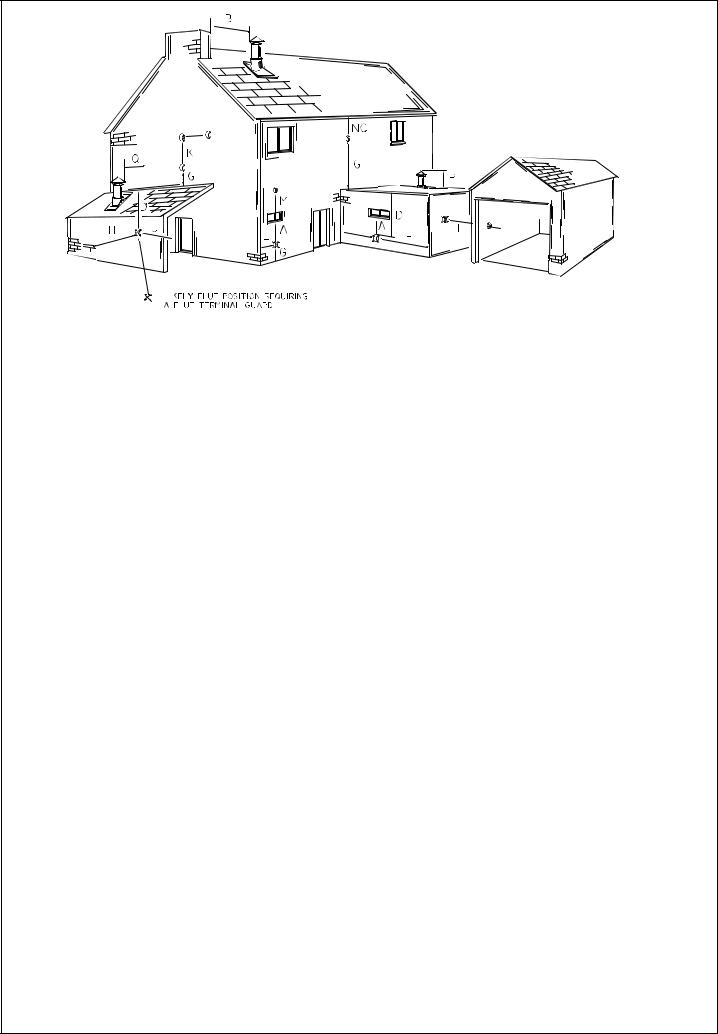
Fig. 6
Terminal position for fan assisted boiler (minimum distance) |
mm |
|
A - |
Directly below an open window or other opening (e.g. air brick) |
300 |
B - |
From a vertical structure on the roof |
150 |
C - |
Below eaves |
200 |
D - |
Below balconies or car port roof |
200 |
E - |
From a vertical drain pipes and soil pipes |
150 |
F - |
From an internal or external corner |
100 |
G - |
Above ground or below balcony level |
300 |
H - |
From a surface facing a terminal |
600 |
I - |
From a terminal facing the terminal |
1200 |
J - |
From an opening in the car port (e.g. door window) into dwelling |
1200 |
K - |
Vertically from a terminal on the same wall |
1500 |
L - |
Horizontally from a terminal on the same wall |
300 |
M - |
Above an opening, air brick, opening windows etc... |
300 |
N - |
Below gutters, soil pipes or drain pipes |
75 |
P - |
Above intersection with roof |
300 |
NOTE: The flue must be terminated in a place not likely to cause a nuisance.
4.6.2A concentric vertical flue kit is available for flueing applications up to a maximum height of 4 metres.
For further details see vertical flue installation instructions.
4.7AIR SUPPLY
4.7.1The following notes are intended for general guidance.
The room sealed fan flued boiler does not require a permanent air vent for combustion air supply.
When installed in a cupboard or compartment ventilation is not required.
4.8WATER CIRCULATION (central heating)
4.8.1 Detailed recommendations |
are |
given in |
|
BS |
6798:1987/5449:1990 |
(for |
smallbore |
and |
microbore central heating |
systems). |
|
The following notes are given for general guidance.
4.8.2Pipework
Copper tubing to BS 2871 1.1.1971 is recommended for water pipes. Jointing should be either with capillary soldered or with compression fittings.
Where possible pipes should have a gradient to ensure air is carried naturally to air release points and water flows naturally to drain taps. It should be ensured as far as possible that the appliance heat exchanger is not a natural collecting point for air except where providing useful heat, pipes should be insulated to prevent heat loss and to avoid freezing. Particular attention should be paid to pipes passing through ventilated spaces in roofs and under floors.
4.8.3An automatic system by-pass is included within the boiler. The boiler is suitable for use in system with thermostatic radiator valves and additional by-pass is required.
12
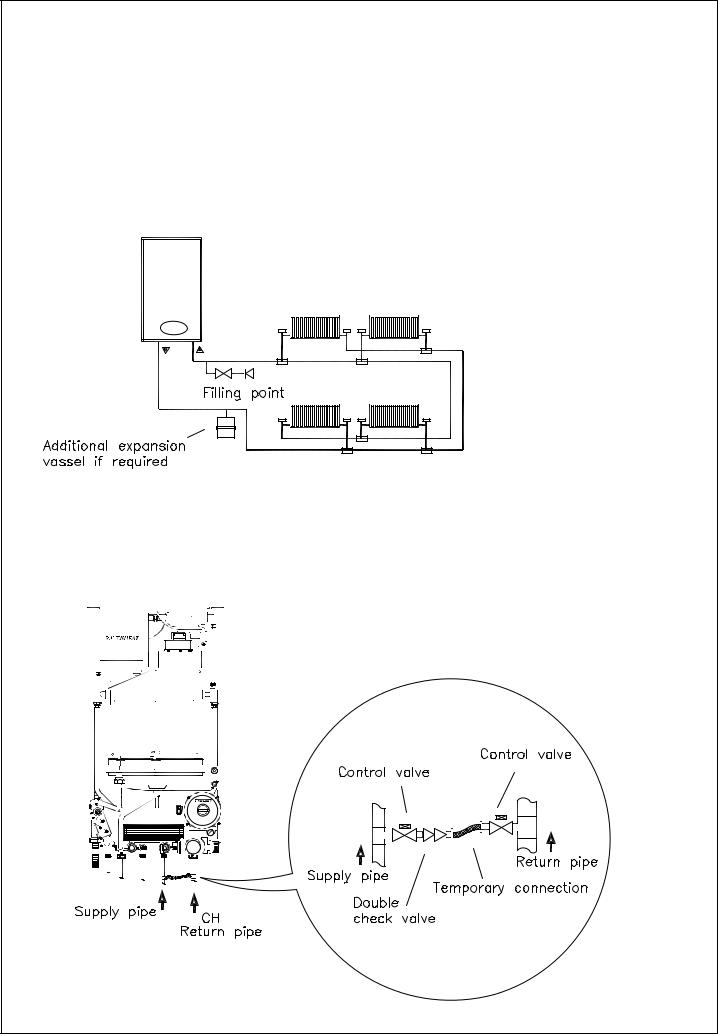
4.8.4Draining tap
These must be located in accessible positions to permit the draining of the whole system. The taps must be at least 15 mm nominal size and manufactured in accordance with BS 2870 1980.
4.8.5Air release points
These must be fitted at all high points where air will naturally collect, and must be sited to facilitate complete filling of the system.
PERMISSIBLE METHOD OF FILLING
4.8.6The appliance has an integral sealed expansion vessel to accommodate the increase of water volume when the system is heated.
It can accept up to 6 Its of expansion water. If the appliance is connected to a system with an unusually high water content, calculate the total expansion and add additional sealed expansion capacity as appropriate (Fig. 7). In general, modern systems will present no problem.
4.8.7Mains water feed: central heating
There must be no direct connection to the mains water supply, even through a non return valve, without the approval of the Local Water Authority.
Fig. 7
Figure 8 depicts the requirements of Diagram R24.2a of the Water Supply (Water Fittings) regulations 1999.
Fig. 8
13

SIZING OF ADDITIONAL EXPANSION VESSEL: TABLE 3
Deduct from the value given in the table the 7 litre vessel supplied.
Safety |
3.0 |
|
|
|
|
|
|
|
|
|
valve setting (bar) |
|
|
|
|
|
|
|
|
|
|
|
|
|
|
|
|
|
|
|
|
|
|
|
|
|
|
|
|
|
|
|
|
Vessel charge |
0.5 |
|
|
|
1.0 |
|
|
1.5 |
|
|
pressure (bar) |
|
|
|
|
|
|
|
|||
|
|
|
|
|
|
|
|
|
|
|
|
|
|
|
|
|
|
|
|
|
|
Initial system |
0.5 |
1.0 |
1.5 |
2.0 |
1.0 |
1.5 |
2.0 |
1.5 |
|
2.0 |
pressure (bar) |
|
|||||||||
|
|
|
|
|
|
|
|
|
|
|
|
|
|
|
|
|
|
|
|
|
|
Total water |
|
|
|
EXPANSION VESSELVOLUME (LITRES) |
|
|
|
|
||
content of system |
|
|
|
|
|
|
|
|||
|
|
|
|
|
|
|
|
|
|
|
|
|
|
|
|
|
|
|
|
|
|
Litres |
|
|
|
|
|
|
|
|
|
|
25 |
2.1 |
3.5 |
6.5 |
13.7 |
2.7 |
4.7 |
10.3 |
3.9 |
8.3 |
|
50 |
4.2 |
7.0 |
12.9 |
27.5 |
5.4 |
9.5 |
20.6 |
7.8 |
16.5 |
|
75 |
6.3 |
10.5 |
19.4 |
41.3 |
8.2 |
14.2 |
30.9 |
11.7 |
24.8 |
|
100 |
8.3 |
14.0 |
25.9 |
55.1 |
10.9 |
19.0 |
41.2 |
15.6 |
33.1 |
|
125 |
10.4 |
17.5 |
32.4 |
68.9 |
13.6 |
23.7 |
51.5 |
19.5 |
41.3 |
|
150 |
12.5 |
21.0 |
38.8 |
82.6 |
16.3 |
28.5 |
61.8 |
23 |
.4 |
49.6 |
175 |
14.6 |
24.5 |
45.3 |
96.4 |
19.1 |
33.2 |
72.1 |
27 |
.3 |
57.9 |
200 |
16.7 |
28.0 |
51 .8 |
110.2 |
21.8 |
38.0 |
82.4 |
31 |
.2 |
66.2 |
225 |
18.7 |
31 .5 |
58.3 |
124.0 |
24.5 |
42.7 |
92.7 |
35.1 |
74.5 |
|
250 |
20.8 |
35.0 |
64.7 |
137.7 |
27.2 |
47.5 |
103.0 |
39 |
.0 |
82.7 |
275 |
22.9 |
38.5 |
71 .2 |
151 .5 |
30.0 |
52..2 |
113.3 |
42.9 |
91.0 |
|
300 |
25.0 |
42.0 |
77.7 |
165.3 |
32.7 |
57.0 |
123.6 |
46.8 |
99.3 |
|
325 |
27.0 |
45.5 |
84.1 |
179.1 |
35.7 |
61 .7 |
133.9 |
50 |
.7 |
107.6 |
350 |
29.1 |
49.0 |
90.6 |
192.8 |
38 .1 |
66.5 |
144.2 |
54.6 |
115.8 |
|
375 |
31 .2 |
52.5 |
97.1 |
206.6 |
40.9 |
71 .2 |
154.5 |
58.5 |
124.1 |
|
400 |
33.3 |
56.0 |
103.6 |
220.4 |
43.6 |
76.0 |
164.8 |
62.4 |
132.4 |
|
425 |
35.4 |
59.5 |
110.1 |
239.2 |
46.3 |
80.7 |
175.1 |
66.3 |
140.7 |
|
450 |
37.5 |
63.0 |
116.5 |
247.9 |
49.0 |
85.5 |
185.4 |
70 |
.2 |
148.9 |
475 |
39.6 |
66.5 |
123.0 |
261 .7 |
51 .8 |
90.2 |
195.7 |
74 |
.1 |
157.2 |
500 |
41.6 |
70.0 |
125.9 |
275.5 |
54.5 |
95.0 |
206.0 |
78 |
.0 |
165.5 |
|
|
|
|
|
|
|
|
|
|
|
For system volumes |
|
|
|
|
|
|
|
|
|
|
other than those given |
|
|
|
|
|
|
|
|
|
|
above, multiply the |
0.0833 |
0.140 |
0.259 |
0.551 |
0.109 |
0.190 |
0.412 |
0.156 |
0.331 |
|
system volume by |
|
|
|
|
|
|
|
|
|
|
the factor across |
|
|
|
|
|
|
|
|
|
|
|
|
|
|
|
|
|
|
|
|
|
Note: This pressure can be increased up to 1.5 bar to suit high static head situations, see item 10, other appliance components in the SERVICING INSTRUCTIONS.
B) Where fitting of a make up vessel would be difficult, RE-PRESSURING of the system can be done. See section on FILLING. If the capacity of the central heating system should exceed 110 Litres, an additional vessel should be installed on the return to the combination boiler from the heating system (Fig. 7). Guidance on vessel sizing is given in (Table 3).
Reference should be made to British Gas Publications, «Material and Installation Specifications for Domestic Central Heating and Hot Water». Draining taps should be at least 1/2” in BSP nominal size and be in accordance with BS 2879.
4.8.8Installation to an existing central heating system.
The combination boiler is designed to operate on a sealed system only. Therefore if the existing system is of the open water type it will have to be modified to comply with BS 5376 Part 2.
Before installing a new combination boiler to an existing system, flush out the old system with a recommended descaling agent.
It is important that the correct concentration of the water treatment product is maintained in accordance with the manufacturers’ instructions.
If the boiler is installed in an existing system any unsuitable additives MUST be removed by thorough cleansing.
BS 7593:1992 details the steps necessary to clean domestic central heating system. Also check pipework and renew any corroded pipework or fittings. Valve glands must be repacked or replaced wherever necessary and any defective controls exchanged.
4.8.9WATER TREATMENT
This boiler has a secondary ALUMINIUM alloy heat exchanger Ravenheat recommended only the use of FERNOXCOPAL or SENTINEL X100 water treatment products, which must be used in accordance with the manufacturers instructions. For further information contact:
Fernox Manufacturing Co. Ltd. Tel 01799 550811
Sentinel Division Betz Dearborn Ltd. Tel. (0151) 424 5351
14

SALAMANDER CURROSION GUARD
Salamander (Eng) Ltd
Tel: (0121) 3780952 /4508
4.8.10Hard water areas.
If the area of installation is recognized as hard water, it is recommended that a suitable water treatment device is installed in the mains.
The water hardness can be determined by using the standard test paper or by referring to local water authority.
4.9DOMESTIC WATER
4.9.1The domestic hot water must be in accordance with the relevant recommendations of BS 5546. Copper tubing to BS 2871 1 is recommended for water carrying pipework and MUST be used for pipework carrying potable water.
4.10ELECTRICAL SUPPLY
Warning: this appliance must be earthed
4.10.1External wiring to the appliance must be carried out by a qualified person and be in accordance with the current I.E.E. Regulations and local regulations which apply. The Ravenheat boiler is supplied for connection to a 230 V ~ 50 Hz single phase supply. The supply must be fused at 3 A.
NOTE. The method of connection to the electricity supply MUST facilitate complete electrical isolation of the appliance, by the use of a fused, double pole isolator, having a contact separation of at least 3 mm in all poles. The point of connection to the electricity supply must be readily accessible and adjacent to the appliance except, where the appliance is installed in a bathroom, this MUST be sited outside the bathroom.
SECTION 5 INSTALLATION
5.1WARNING
5.1.1It is MOST IMPORTANT that this appliance is installed in a VERTICAL POSITION, with the flue air duct passing through the wall.
Make sure flue slopes 2.5° down towards the boiler that is 45 mm/m fall per metre of flue length (Fig. 22).
Fig. 9
15
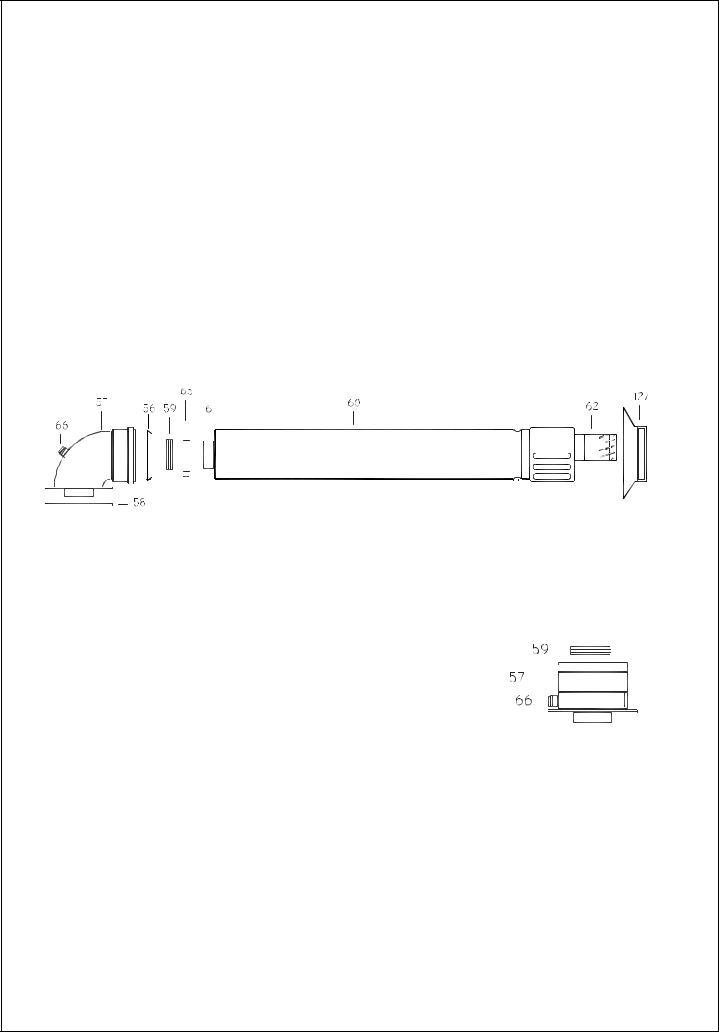
5.2DELIVERY
5.2.1The appliance carton containing (fig 9):
a)boiler fully assembled
b)installation instructions and user instructions
c)white paper template.
Polythene bag containing
a)2-22 mm compression ball valve complete with 3/4” washers.
b)1-15 mm compression ball valve complete with 1/2” washers.
c)1-15 mm compression ball valve.
d)2 coach bolts and wall plugs.
e)screws and dowels
Fig. 10
OPTIONAL EXTRAS:
Small carton containing (fig. 11):
57 - Straight header supplied as an extra cost only when requested
59 - Rubber seal Ø 60
66 - Flue gas sample point
FLUE EXTENSION BOX CONTAINING (fig. 12):
1000 mm flue extension duct as an extra cost only when requested for side and vertical flue applications
59 - Rubber seal Ø 60
63 - Air intake duct extension
64 - Flue exhaust duct extension
65 - Pipe centering spring
Horizontal CSI flue kit (sold separate) Fig. 10.
57 - Flue bend assembly
59 - Rubber seal Ø 60
60 - Air intake duct
61 - Flue exhaust duct
62 - Terminal
65 - Pipe centering spring
66 - Flue gas sample point
127 - Terminal Rubber.
WARNING
Maximum allowable flue length 2.5 m horizontal maximum No 2x1000 mm.
Flue duct extension used with standard flue.
Fig. 11
Fig. 12
16
